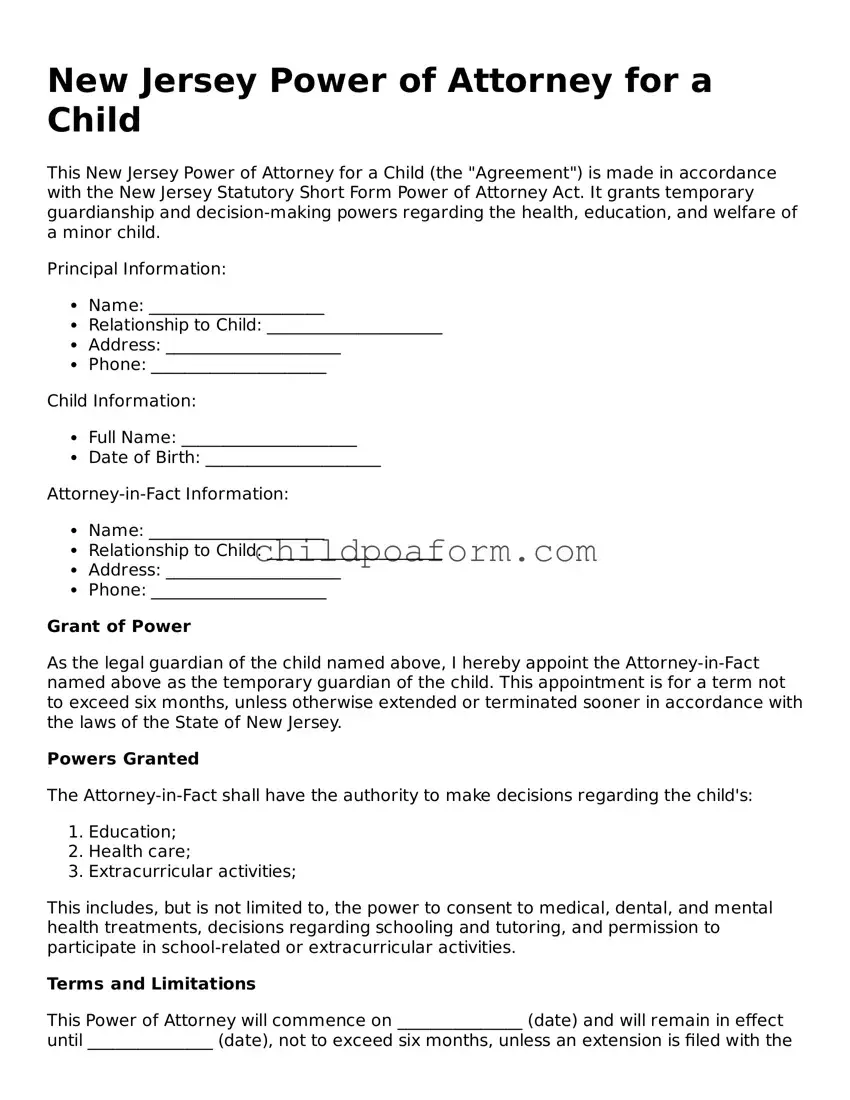Instructions on Utilizing New Jersey Power of Attorney for a Child
Creating a Power of Attorney (POA) for a child is a significant step for parents or guardians needing to authorize another responsible adult to make decisions for their child temporarily. This could be necessary under various circumstances, such as when the parents or guardians are out of town, dealing with health issues, or for reasons related to the child's education or healthcare. The New Jersey Power of Attorney for a Child form allows parents or guardians to appoint someone they trust to temporarily have legal authority over their child’s welfare. Navigating through the process of completing this form can seem daunting at first. However, by following a series of straightforward steps, one can ensure the form is filled out correctly, reflecting the faith and trust placed in the designated individual.
- Step 1: Begin by acquiring the most current New Jersey Power of Attorney for a Child form. Make sure you have the latest version to comply with New Jersey laws.
- Step 2: Carefully read through the entire form before filling anything out. Understanding every section in advance will help you complete the form accurately and with confidence.
- Step 3: Fill in the child's full legal name and date of birth in the designated sections at the top of the form.
- Step 4: Enter the full legal name(s) of the parent(s) or guardian(s) granting the power of attorney, along with their contact information, including address and phone number.
- Step 5: Specify the full legal name of the individual being granted the power of attorney to make decisions for the child. Include the appointee’s contact information as well.
- Step 6: Detail the specific powers being granted through this POA. Be as clear and precise as possible about what decisions the appointed individual can make on behalf of the child. This can range from educational decisions, such as the ability to communicate with school officials, to medical decisions, including consent for treatment.
- Step 7: Indicate the effective date of the POA and, if applicable, the expiration date. Many POAs for a child have a set duration, after which they either need to be renewed or will automatically expire.
- Step 8: Review the form with the designated person receiving the power of attorney. It’s crucial they understand the responsibilities they're agreeing to take on and are willing to act in the child’s best interest.
- Step 9: Have all parties involved sign the form. This includes the parent(s) or guardian(s), the appointed individual, and, in some cases, the child, depending on their age and the form’s requirements.
- Step 10: Notarize the form if required. Some POAs must be notarized to be legally binding. Check the specific requirements for the State of New Jersey and ensure you follow them to validate the agreement.
- Step 11: Distribute copies of the completed form to all involved parties, including the appointed individual and any institutions (such as schools or healthcare providers) that may require a copy to recognize the POA.
Completing the New Jersey Power of Attorney for a Child form is a proactive step in ensuring a child's needs are met, even in the absence of their parent or legal guardian. Though the task requires attention to detail, the peace of mind it provides makes it well worth the effort. By clearly defining the scope of the appointed individual's authority and responsibilities, parents or guardians can ensure their child is in safe hands, maintaining their well-being as the top priority.
